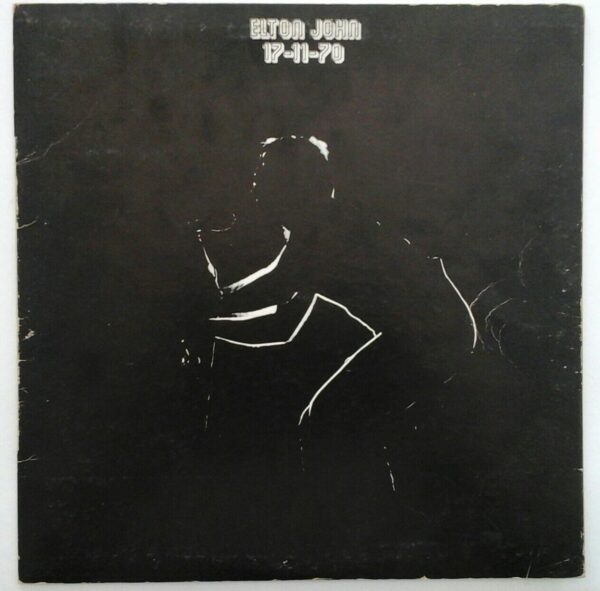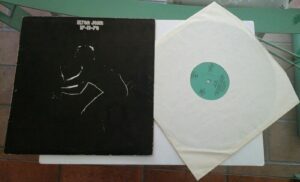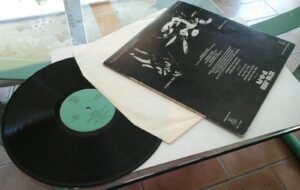Descrizione
PREMESSA: LA SUPERIORITA’ DELLA MUSICA SU VINILE E’ ANCOR OGGI SANCITA, NOTORIA ED EVIDENTE. NON TANTO DA UN PUNTO DI VISTA DI RESA, QUALITA’ E PULIZIA DEL SUONO, TANTOMENO DA QUELLO DEL RIMPIANTO RETROSPETTIVO E NOSTALGICO , MA SOPRATTUTTO DA QUELLO PIU’ PALPABILE ED INOPPUGNABILE DELL’ ESSENZA, DELL’ ANIMA E DELLA SUBLIMAZIONE CREATIVA. IL DISCO IN VINILE HA PULSAZIONE ARTISTICA, PASSIONE ARMONICA E SPLENDORE GRAFICO , E’ PIACEVOLE DA OSSERVARE E DA TENERE IN MANO, RISPLENDE, PROFUMA E VIBRA DI VITA, DI EMOZIONE E DI SENSIBILITA’. E’ TUTTO QUELLO CHE NON E’ E NON POTRA’ MAI ESSERE IL CD, CHE AL CONTRARIO E’ SOLO UN OGGETTO MERAMENTE COMMERCIALE, POVERO, ARIDO, CINICO, STERILE ED ORWELLIANO, UNA DEGENERAZIONE INDUSTRIALE SCHIZOFRENICA E NECROFILA, LA DESOLANTE SOLUZIONE FINALE DELL’ AVIDITA’ DEL MERCATO E DELL’ ARROGANZA DEI DISCOGRAFICI .
ELTON JOHN
17-11-70
Disco LP 33 giri , 1971, DJM – Dick James Music Co. Limited / Ricordi, serie International, SNIR-DJ 25035 , Italia, first pressing
BUONISSIME CONDIZIONI, vinyl ex- , cover vg++
17-11-70 (11-17-70 negli Stati Uniti) è il quarto album dell’artista britannico Elton John e il suo primo album live, pubblicato il 10 maggio 1971.
Elton si era appena fatto conoscere in America con la distribuzione
dell’album omonimo, nel 1970. Tornato negli Stati Uniti alla fine dello
stesso anno, gli fu proposta un’esibizione ai A&R Recording Studios
di New York
(sarebbe poi stata trasmessa da un’emittente radiofonica americana,
oltre che registrata). Ebbe così inizio lo show, che mandò il pubblico
in delirio: Elton, formidabile al pianoforte e accompagnato solo da Dee Murray al basso e da Nigel Olsson alla batteria, dimostrò di essere un fenomeno sensazionale,
unico nel suo genere, e solo pochissimi artisti riuscirono ad
eguagliare la sua abilità nei live, dove egli si fondeva con il suo
strumento fino a divenirne un tutt’uno. Oltre a vari brani in
maggioranza tratti dai suoi album precedenti, celebrò i Beatles, i Rolling Stones e Elvis Presley,
che furono tra i suoi più grandi ispiratori, eseguendo tre canzoni
prese dal loro repertorio. Secondo il racconto del DJ Dave Herman, a un
certo punto del concerto Elton si tagliò la mano; alla fine dello show,
la tastiera del pianoforte era quindi ricoperta di sangue.
Dopo la registrazione dell’album si pensò di distribuirlo insieme ad Empty Sky,
che non era ancora uscito negli Stati Uniti (arriverà sul mercato
americano solo nel 1975), in seguito però si decise di pubblicarlo
subito da solo, per frenare la circolazione di bootleg. Oggi, sebbene
spesso a torto dimenticato, è considerato come uno dei live migliori
dell’intera carriera di Elton, se non il migliore.
- Etichetta: DJM RECORDS
- Catalogo: SNIR – DJ 25035
- Data di pubblicazione: 1971
- Matrici : SNIR-DJ-25035-1 / SNIR-DJ-25035-2
- Data Matrici : 22/7/71
- Supporto:vinile 33 giri
- Tipo audio: stereo
- Dimensioni: 30 cm.
- Facciate: 2
- Green label, white paper inner sleeve
The great thing about this early live record is its obscurity — not
just that this isn’t one of his better-known records, but that the set
list is a fanboy’s dream, heavy on album tracks, covers, and the kinds
of song that make Elton John’s early work so individual. It’s not just
that there are no hits here, but it’s that these six songs emphasize the spare, hard-rocking bluesy
singer/songwriter that may not have written his own words, but always
sang them with conviction and melodies that made them seem like his
own. This may be a minor effort in his catalog, but that’s part of its
pleasure — it’s certainly a record from the time before Elton the
superstar, as he tears through Tumbleweed Connection
tracks prior to the record’s release, does a phenomenal reworking of
“Honky Tonk Women,” hauls out B-sides like “Bad Side of the Moon,” and
gives a fierce, infectious performance. It’s not essential for anyone
but obsessives, but if you want any indication of what Elton sounded
like prior to his big break, this is an excellent, even intoxicating,
summary.
Tracce
All songs by Elton John and Bernie Taupin, except where noted.
Side one
- “Take Me to the Pilot” – 6:43
- “Honky Tonk Women” (Mick Jagger, Keith Richards) – 4:09
- “Sixty Years On” – 8:05
- “Can I Put You On” – 6:38
Side two
- “Bad Side of the Moon“– 4:30
- Burn Down the Mission” including “My Baby Left Me” (Arthur Crudup) , “Get Back” (John Lennon, Paul McCartney) – 18:20
The performances on this album were recorded during a live radio
concert, broadcast in New York by WABC-FM on November 17th, 1970. The
broadcast originated at A&R Recording Studios, New York. The Tapes
were mixed at Trident Studios, London.
Personnel
- Elton John – piano, Vocals
- Dee Murray – bass, backing vocals
- Nigel Olsson – drums, backing vocals
Production
- Producer: Gus Dudgeon
- Engineer: David Hentschel, Phil Ramone
- Coordination: Steve Brown, Joe Disabato
- Design: David Larkham
- Photography: David Larkham
- Liner notes: Gus Dudgeon, John Tobler
- Emcee: Dave Herman
Elton John -17 -11-70 (1971)
(che negli Usa si intitola 11-17-70) è il primo album live
di Elton John, spesso a torto dimenticato e poco considerato. Proviene da una
registrazione radiofonica che immediatamente arrivò sul
mercato sotto forma di bootleg, per cui la casa discografica
pensò bene di renderla ufficiale e di pubblicarla
all’istante. Elton pensava di allegare l’album gratuitamente
a Empty Sky (che non era ancora disponibile in USA, dove tra l’altro il cielo oltre che vuoto è anche triste), ma
quest’ultimo arrivò sul mercato statunitense solo nel 1975 e
il live fu pubblicato da solo. E’ una formidabile
testimonianza del trio con Elton al piano, Dee Murray al basso e Nigel
Olsson alla batteria durante il primo tour che lo trasformò
in una superstar anche al di là dei confini del suo pianerottolo.

Alla fine del 1970, Elton John aveva appena
iniziato ad aprirsi un varco in Gran Bretagna, avendo già fatto, in materia di
popolarità, significativi passi in avanti negli Stati Uniti. Il suo primo
singolo da hit inglese arrivò nel primo 1971, con ‘Your Song’ (dall’LP ‘Elton
John’), in America insieme a ‘Border Song’ (dello stesso album), e ‘Your Song’
aveva raggiunto la classifica dei singoli ‘Billboard’ nella seconda metà del
1970. Fu quasi lo stesso con i suoi album – l’LP ‘Elton John’ fu un immediato
successo negli Stati Uniti, diventando il primo album con certificazione ‘gold’
di Elton e raggiungendo la Top 5 della classifica ‘Billboard’ nella quale rimase
effettivamente per un anno intero, mentre in Gran Bretagna, dove esso fu
distribuito diversi mesi prima, ricevette giudizi
eccellenti ma impegnò per meno di quattro mesi, innalzandosi solo
appena oltre la Top 10. Elton, negli U.S.A., era invece subito riconosciuto
come un contendente, ma ciò simultaneamente ne causò una minore diffusione nella
sua nazione. Era stata formata una Elton John Band nel
1970, comprendente il bassista Dee Murray e il batterista Nigel Olsson, ma
i loro primi show in Gran Bretagna apparentemente non furono di certo accolti
con entusiasmo, sebbene i successi europei avessero probabilmente portato
un pò di consolazione. La svolta arrivò quando Elton, Dee e Nigel si esibirono
nel loro primo show in America, una residenza settimanale al famoso club
‘Troubadour’ di Los Angeles. John, prima apparentemente una celebrità da
scoprire per il pubblico, divenne letteralmente e subito un avvenimento
sensazionale – Robert Hillburn del Los Angeles Time lo definì ‘magnificente’ e
‘una nuova star’, risultante nell’LP ‘Elton John’ divenuto un immediato (e ben
meritato) successo quando fu distribuito poche settimane dopo. Elton,
incredibilmente prolifico, aveva già distribuito il suo terzo LP
studio, ‘Tumbleweed Connection’, come al solito prima in Gran Bretagna e
dopo negli Stati Uniti. Nel frattempo, era stato invitato di nuovo negli U.S.A.
per un altro tour, comprendente uno show (ai A&R Recording Studios a
New York di fronte ad un pubblico invitato) che sarebbe stato trasmesso live in
radio (americana). Elton ricordò dopo: “During our second tour of The States,
which was mostly co – headlining with people like Leon Russel, The Byrds,
Poco, The Kinks and so on, we were asked if we’d like to do a live broadcast.
This hadn’t been done in New York for years, and the radio station said it could
be done in a studio, sent out in stereo, and that the sound would be really
good. We played in headphones, and it all came out of this little recording
studio which had an audience of about a hundred to create the concert hall
atmosphere. We didn’t know at the time, but afterwards we found that Steve Brown
had arranged fon an 8 – track recording to be made – just to see how it came out
– and when we listened to it, we thought it was quite good. The ‘Friends’
album (la colonna sonora di un film), over which we had no control, was
about to come out, so we did a quick mix of the live recording at DJM and
released an album from the tapes. A the time, I thought it was quite good,
and I also wanted it to come out because Dee and Nigel, who had been on very
little before, were featured very strongly. It meant that I had four albums in
the US Top 40, which hadn’t been done since The Beatles”. Negli Stati
Uniti, tre nuovi album di Elton John furono distribuiti in rapida successione
– ‘Tumbleweed Connection’ nel primo 1971, ‘Friends’ in marzo, e in
maggio ’11 – 17 – 70′ (quest’ultimo un LP live, che prese il nome dalla
data di registrazione) – in Gran Bretagna, dove la data é espressa in giorni,
mesi e anni, fu subito rinominato ’17 – 11 – 70′. Elton disse in
un’intervista del 1971 che guardava alla versione americana in maniera
superiore, essendo stata remixata dalla American studio star Phil Ramone,
il tecnico della registrazione originale. Comunque, grazie alla tecnologia
degli anni ’90 usata per questa versione rimasterizzata di Gus Dudgeon,
accreditato come produttore nella versione originale nel Regno Unito, Elton
probabilmente cambiò opinione… Forse la precedente occhiata era rivolta
all’estensione connessa al repertorio necessariamente limitato che esibì
nell’album. ‘Take Me To The Pilot’ (originaria dell’album ‘Elton John’) fu
ricevuta dal pubblico come il Secondo Avvento, e Elton fu abbastanza
imbarazzato nell’impersonare il team di commedie inglesi molto amate,
conosciuto come ‘The Goons’ (Peter Sellers, Spike Milligran e Harry
Secombe), dicendo ‘Stop it, I tell you, stop it’. A mantenere la frenesia fu la
versione cover di ‘Honky Tonk Women’ dei Rolling Stones, che Elton cominciò
iniziando a cappella con accordi in tre parti, suonando poi con entusiasmo
considerevole e finendo nello stile di Leon Russel, con un pericoloso coro
finale e una bella chiusura in crescendo. ‘Sixty Years On’ (anch’essa dell’album
‘Elton John’) suonò inevitabilmente in maniera diversa in assenza degli
archi decoranti la versione studio, ma non fu meno eccellente di quest’ultima, e
l’inclusione di una canzone dell’imminente (all’epoca) LP ‘Friends’,
menzionante numerosi luoghi britannici, é una rara versione live di
una canzone che Elton ha difficilmente eseguito in concerto. Stesso discorso per
‘Bad Side Of The Moon’, l’attuale (del tempo) singolo di Elton negli Stati
Uniti, e ciò spiegò l’omissione di ‘Your Song’, che fu distribuita come singolo
negli U.S.A. circa due settimane dopo la registrazione di quest’album.
L’unica traccia bonus qui, inizialmente non distribuita, é ‘Amoreena’, un’altra
delle sue canzoni meno familiari dell’LP ‘Tumbleweed Connection’ – Amoreena,
casualmente, é il nome della figlioccia di Elton. Infine, l’istigante ‘Burn Down
The Mission’ (anche traccia finale in ‘Tumbleweed Connection’) era stata
ingegnosamente arrangiata così da incorporare ciascun verso di ‘My Baby Left
Me’, di Elvis Presley, e ‘Get Back’, la molto familiare hit dei Beatles.
Elton é sempre stato generoso nell’ammettere le influenze musicali altrui,
e l’includere nelle sue canzoni da trasmettere in radio le forse tre più grandi
star dell’era rock (Presley, i Beatles e gli Stones) fu plausibilmente un
acuto riferimento a questi eroi. Il produttore Gus Dudgeon nota: “A very nervous
three piece band played a short concert to an invited audience in New York,
which was broadcast live. It was heavily bootlegged, and thus this ‘official’
album was issued with much improved sound quality to eliminate the pirated
versions”. Usando la tecnologia degli anni ’90, il suono é stato
ulteriormente intensificato da Dudgeon, e ’17 – 11 – 70′ ora suona meglio di
prima. Nonostante sia l’unica registrazione legale della performance del primo
live della Elton John Band, questo storico album é stato spesso trascurato in
passato, ma forse merita finalmente una rivalutazione…

Jim Morrison used to toy with this idea of
starting an album with the sounds of a guy driving around with the rain
pouring down. Finally the guy turns the radio on and lo and behold it’s
the new Doors album. Naturally Paul Rothchild nixed the idea so it
never got done. So we’ve got to settle for an Elton John radio album
instead. I mean who else could ever do it in a million years but the
master of preciousness? Like he couldn’t have done it on AM, it had to
be FM. At least it wasn’t a live concert on WNEW-FM, that might
have been unbearable unless Zacherle MCed it. No, it was on WABC-FM
(now WPLJ) on the anniversary of the Bolshevik Revolution (November 17,
1917?) or something like that. The cover of the album documenting it’s
in black and white (there’s no such thing as color radio) and of course
so’s his reputation as the new Jagger.
Well some people call him Jagger but not me: he’s just Jose
Feliciano with a twist of Johnny Mathis. That ain’t bad when it’s free
over the airwaves every once in a while. But if you have to turn back
the hands of time and pay for the trip then you might as well just sit
there feeling bad that you missed the original show. Well at least the
album does one thing, it removes any specialness the event might have
had as a forgotten fragment of ephemeral hokum. “Honky Tonk Women” is
on it but is there one town in the US of A that doesn’t have a band
with “Honky Tonk Women” in its repertoire? And “Take Me to the Pilot”
but you can hear that elsewhere, too. So even ephemera are filled with
little more than the tried and true anyway.
Movie soundtracks are something else again. They’re not free but
they sure cost less than an album and you get a picture along with it
at no extra cost. Most of the sales from albums thereof are reputed to
be of the souvenir variety, y’know because the movie was so super. But
then rock guys started doing soundtracks for pictures they weren’t in
and for pictures nobody’d ordinarily bother seeing anyway. So a
situation arose where maybe people would catch the movie for just the
soundtrack by a big name otherwise irrelevant to the film, take a
chance with it, that sort of thing. Like go see The Family Way because McCartney did some of the music, or Here We Go Round the Mulberry Bush
because of Traffic and Spencer Davis. But once you’ve been burned a
couple times like that you’re not even gonna bother with even just the album. Particularly when the stuff packaged on the album is unavailable anywhere else. Which is the case with Friends.
I mean I didn’t even wanna listen to this album at first, even
though it was free. (I don’t know about you but I got it free.) But
even a tubercular owl deserves a chance so I put it on. And here’s what
I discovered: “Variations on Michelle’s Song” and “I Meant to Do My
Work Today” both contain introductions composed by Paul Buckmaster!
That’s right, Paul Buckmaster. Yes that’s the same Paul Buckmaster who
made Sticky Fingers palatable with his nifty string wizardry.
Yeah, Paul Buck-master, the one and only. But I don’t wanna neglect
Elton so here’s the word on him: why’d they have to mess up an
otherwise innocuous soundtrack with words and singing, huh?
A guess as to what kind of movie Friends is: probably a lot like Melody
(music by the Bee Gees and CSNY), which I happened to see on the TWA
flight I took to get to this typewriter. In any event, there must be at
least 30 people who have already seen Friends two or more times
just to listen to Elton backed up by all the plushy visuals. Here’s
what I have to say to all 30 of you: hi, I hope you’re enjoying
yourselves.
| Biography | |
|
In The son of a former Royal Air Force trumpeter, John was born Reginald John and Taupin were hired by Dick James to become staff songwriters at his fledgling DJM in 1968. The pair collaborated at a rapid rate, with Taupin For his second album, John and Taupin hired producer Gus Dudgeon and arranger Paul Buckmaster, who contributed grandiose string charts to Elton John. Released in the summer of 1970, Elton John Between 1972 and 1976, John and Taupin‘s Throughout the mid-’70s, John’s concerts were enormously popular, as John reunited with Taupin for 1980’s 21 at 33, Following a record-breaking five-date stint at Madison Square Garden in In 1992, John returned to active recording with The One. Peaking at number eight on the U.S. charts and going double platinum, the album became his most successful record since Blue Moves and sparked a career renaissance for John. He and Taupin With the profits earmarked for Diana’s favorite charities, and with a |
|







